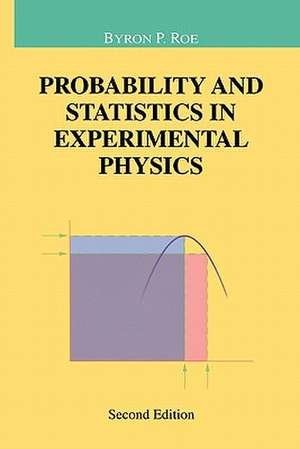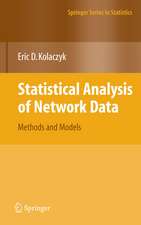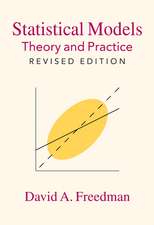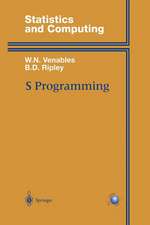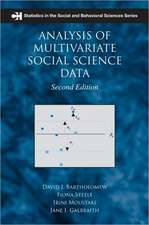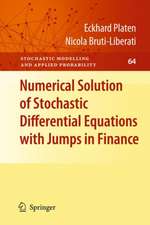Probability and Statistics in Experimental Physics: Undergraduate Texts in Contemporary Physics
Autor Byron P. Roeen Limba Engleză Paperback – 6 dec 2010
| Toate formatele și edițiile | Preț | Express |
|---|---|---|
| Paperback (1) | 386.61 lei 6-8 săpt. | |
| Springer – 6 dec 2010 | 386.61 lei 6-8 săpt. | |
| Hardback (1) | 393.90 lei 6-8 săpt. | |
| Springer – 21 iun 2001 | 393.90 lei 6-8 săpt. |
Preț: 386.61 lei
Nou
Puncte Express: 580
Preț estimativ în valută:
73.98€ • 76.32$ • 61.74£
73.98€ • 76.32$ • 61.74£
Carte tipărită la comandă
Livrare economică 26 martie-09 aprilie
Preluare comenzi: 021 569.72.76
Specificații
ISBN-13: 9781441928955
ISBN-10: 1441928952
Pagini: 268
Ilustrații: XI, 252 p.
Dimensiuni: 155 x 235 x 14 mm
Greutate: 0.38 kg
Ediția:Softcover reprint of the original 2nd ed. 2001
Editura: Springer
Colecția Springer
Seria Undergraduate Texts in Contemporary Physics
Locul publicării:New York, NY, United States
ISBN-10: 1441928952
Pagini: 268
Ilustrații: XI, 252 p.
Dimensiuni: 155 x 235 x 14 mm
Greutate: 0.38 kg
Ediția:Softcover reprint of the original 2nd ed. 2001
Editura: Springer
Colecția Springer
Seria Undergraduate Texts in Contemporary Physics
Locul publicării:New York, NY, United States
Public țintă
GraduateCuprins
1. Basic Probability Concepts.- 2. Some Initial Definitions.- 2.1 Worked Problems.- 2.2 Exercises.- 3. Some Results Independent of Specific Distributions.- 3.1 Multiple Scattering and the Root N Law.- 3.2 Propagation of Errors; Errors When Changing Variables.- 3.3 Some Useful Inequalities.- 3.4 Worked Problems.- 3.5 Exercises.- 4. Discrete Distributions and Combinatorials.- 4.1 Worked Problems.- 4.2 Exercises.- 5. Specific Discrete Distributions.- 5.1 Binomial Distribution.- 5.2 Poisson Distribution.- 5.3 Worked Problems.- 5.4 Exercises.- 6. The Normal (or Gaussian) Distribution and Other Continuous Distributions.- 6.1 The Normal Distribution.- 6.2 The Chi-square Distribution.- 6.3 F Distribution.- 6.4 Student’s Distribution.- 6.5 The Uniform Distribution.- 6.6 The Log-Normal Distribution.- 6.7 The Cauchy Distribution (Breit-Wigner Distribution).- 6.8 Worked Problems.- 6.9 Exercises.- 7. Generating Functions and Characteristic Functions.- 7.1 Introduction.- 7.2 Convolutions and Compound Probability.- 7.3 Generating Functions.- 7.4 Characteristic Functions.- 7.5 Exercises.- 8. The Monte Carlo Method: Computer Simulation of Experiments.- 8.1 Using the Distribution Inverse.- 8.2 Method of Composition.- 8.3 Acceptance Rejection Method.- 8.4 Computer Pseudorandom Number Generators.- 8.5 Unusual Application of a Pseudorandom Number String.- 8.6 Worked Problems.- 8.7 Exercises.- 9. Queueing Theory and Other Probability Questions.- 9.1 Queueing Theory.- 9.2 Markov Chains.- 9.3 Games of Chance.- 9.4 Gambler’s Ruin.- 9.5 Exercises.- 10. Two-Dimensional and Multidimensional Distributions.- 10.1 Introduction.- 10.2 Two-Dimensional Distributions.- 10.3 Multidimensional Distributions.- 10.4 Theorems on Sums of Squares.- 10.5 Exercises.- 11. The Central Limit Theorem.- 11.1Introduction; Lindeberg Criterion.- 11.2 Failures of the Central Limit Theorem.- 11.3 Khintchine’s Law of the Iterated Logarithm.- 11.4 Worked Problems.- 11.5 Exercises.- 12. Inverse Probability; Confidence Limits.- 12.1 Bayes’ Theorem.- 12.2 The Problem of A Priori Probability.- 12.3 Confidence Intervals and Their Interpretation.- 12.4 Use of Confidence Intervals for Discrete Distributions.- 12.5 Improving on the Symmetric Tails Confidence Limits.- 12.6 When Is a Signal Significant?.- 12.7 Worked Problems.- 12.8 Exercises.- 13. Methods for Estimating Parameters. Least Squares and Maximum Likelihood.- 13.1 Method of Least Squares (Regression Analysis).- 13.2 Maximum Likelihood Method.- 13.3 Further Considerations in Fitting Histograms.- 13.4 Improvement over Symmetric Tails Confidence Limits for Events With Partial Background-Signal Separation.- 13.5 Estimation of a Correlation Coefficient.- 13.6 Putting Together Several Probability Estimates.- 13.7 Worked Problems.- 13.8 Exercises.- 14. Curve Fitting.- 14.1 The Maximum Likelihood Method for Multiparameter Problems.- 14.2 Regression Analysis with Non-constant Variance.- 14.3 The Gibb’s Phenomenon.- 14.4 The Regularization Method.- 14.5 Other Regularization Schemes.- 14.6 Fitting Data With Errors in Both x and y.- 14.7 Non-linear Parameters.- 14.8 Optimizing a Data Set With Signal and Background.- 14.9 Robustness of Estimates.- 14.10 Worked Problems.- 14.11 Exercises.- 15. Bartlett S Function; Estimating Likelihood Ratios Needed for an Experiment.- 15.1 Introduction.- 15.2 The Jacknife.- 15.3 Making the Distribution Function of the Estimate Close to Normal; the Bartlett S Function.- 15.4 Likelihood Ratio.- 15.5 Estimating in Advance the Number of Events Needed for an Experiment.- 15.6 Exercises.- 16. InterpolatingFunctions and Unfolding Problems.- 16.1 Interpolating Functions.- 16.2 Spline Functions.- 16.3 B-Splines.- 16.4 Unfolding Data.- 16.5 Exercises.- 17. Fitting Data with Correlations and Constraints.- 17.1 Introduction.- 17.2 General Equations for Minimization.- 17.3 Iterations and Correlation Matrices.- 18. Beyond Maximum Likelihood and Least Squares; Robust Methods.- 18.1 Introduction.- 18.2 Tests on the Distribution Function.- 18.3 Tests Based on the Binomial Distribution.- 18.4 Tests Based on the Distributions of Deviations in Individual Bins of a Histogram.- 18.5 Exercises.- References.
Recenzii
From the reviews of the second edition:
"This book is the second edition … of a practical introduction into probability and statistics in experimental physics. The book is primarily written for undergraduate and graduate students and contains a new chapter on queueing theory and an additional discussion of the Feldman-Cousins unified method for estimating confidence intervals." (Ulrich Horst, Zentralblatt MATH, Vol. 1011, 2003)
"The book under review is rather unconventional in many respects, in particular concerning the choice of covered topics and the style of presentation. … Its main goal is to provide the reader with techniques actually used in experimental research. They are illustrated by a series of worked problems. … some material is included that one hardly finds in other books of this kind, like elements of queuing theory … . many experimental physicists would appreciate probably to have a copy of this book within hand-reach." (F. Binon, Physicalia, Vol. 38 (5), 2002)
"This book is the second edition … of a practical introduction into probability and statistics in experimental physics. The book is primarily written for undergraduate and graduate students and contains a new chapter on queueing theory and an additional discussion of the Feldman-Cousins unified method for estimating confidence intervals." (Ulrich Horst, Zentralblatt MATH, Vol. 1011, 2003)
"The book under review is rather unconventional in many respects, in particular concerning the choice of covered topics and the style of presentation. … Its main goal is to provide the reader with techniques actually used in experimental research. They are illustrated by a series of worked problems. … some material is included that one hardly finds in other books of this kind, like elements of queuing theory … . many experimental physicists would appreciate probably to have a copy of this book within hand-reach." (F. Binon, Physicalia, Vol. 38 (5), 2002)
